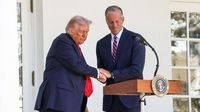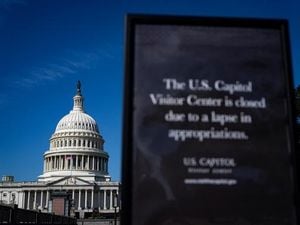The United States government shutdown, now stretching into its fourth week, has officially become the longest in American history as of October 22, 2025. The impasse has left millions of Americans without crucial services, federal workers without pay, and the country’s political leadership locked in a bitter standoff with no clear end in sight. The roots of this crisis, the political theater that has unfolded, and the mounting pressure on both parties reveal a complex web of blame, calculation, and frustration.
According to Axios, the crisis has been brewing since March 2025, when Senate Majority Leader Chuck Schumer voted in favor of the same clean continuing resolution (CR) that now sits stalled before the Senate. In the months that followed, political winds shifted. Far-left activists and some congressional Democrats began calling for Schumer to step aside, and under mounting pressure, he reversed his position and now opposes the very CR he once supported. The shutdown, critics argue, was months in the making—a product of political fear, outside pressure, and a brewing showdown over government funding.
In early September, the stage was set for confrontation. The “No Kings” rally, scheduled and funded by a network of dark-money donors including George Soros, marked a turning point. As reported in party communications and highlighted by Axios, this rally and subsequent “Hate America” protests became focal points for Democratic activists, drawing sharp criticism from Republicans who saw the events as divisive and anti-American. “The ‘Hate America’ rally wasn’t about peace or policy—it was about hate, violence, and division,” Republican messaging claimed, pointing to signs and slogans they described as violent threats and anti-American speech.
As the rallies faded and the government remained shuttered, the blame game intensified. House Republicans, having already passed what they described as a "clean, responsible bill" to reopen the government through November 21, argued that Democrats were prolonging the shutdown for political theater. “Democrats had their rallies, their protests, and their political theater. The American people have had enough. It’s time for Democrats to end the shutdown they created and get back to work for the country,” Republican leadership declared.
But the story, as reported by CNN, is far from one-sided. Republican leaders have stuck to a hardline position: no negotiations with Democrats until the shutdown ends. House Speaker Mike Johnson and Senate Majority Leader John Thune have managed the Republican stance, refusing to entertain any talks with Democrats and vowing not to concede on key issues like health care in exchange for government funding. Johnson, keeping close contact with President Donald Trump, was unequivocal: “He (Trump) is not going to negotiate with the Democrats, who have taken the American people hostage. We’re not going to pay a ransom to reopen the government.”
That strategy, while projecting unity, has started to sow seeds of doubt within Republican ranks. Several GOP lawmakers have begun to question whether a change in tactics is needed. They have suggested that President Trump, known for his dealmaking persona, should take a more direct role in resolving the standoff. “If he gets involved, he can move it. He can make a decision on what we do,” said Senator Tommy Tuberville. Representative Jeff Van Drew echoed the sentiment: “We absolutely need him. He has the strength and skills to get it done. The speaker is doing a great job, but we need Trump.”
Despite these calls, Trump has so far kept his distance from direct negotiations, preferring to let Johnson and Thune manage the shutdown. He has not spoken with Schumer or House Democratic leader Hakeem Jeffries since before the government shuttered, a White House official confirmed. Instead, Trump has hosted Senate Republicans at the White House, using the opportunity to encourage continued solidarity and to predict that Democrats would ultimately lose out politically. “They are the obstructionists,” Trump declared at a recent lunch, “The reason they’re doing it is because we’re doing so well.”
Yet, behind the scenes, Trump has wielded the shutdown as a tool to reshape government operations. The White House has sought to fire more than 4,000 government employees and has halted billions of dollars in infrastructure and energy projects in Democratic states and districts. Budget chief Russell Vought signaled ambitions to lay off more than 10,000 federal workers in total. At the same time, Trump has redirected funding to ensure that military service members and law enforcement officers continue to receive pay, allowing his administration’s crime and immigration initiatives to move forward even as other government functions grind to a halt. “They’re not going to get a lot of things back,” Trump said of the cuts, adding, “maybe indirectly, they’re doing good” by giving the administration an excuse to trim what he views as unnecessary parts of the government.
The toll of the shutdown is mounting. As reported by ABC News, federal employees are set to miss their first full paycheck on Friday, October 24, 2025. Starting Monday, October 27, all federal courts will no longer have funding to sustain full, paid operations. The Senate, which returned on October 20, failed for the 11th time to advance a bill to reopen the government. The House, meanwhile, remains out of session, with Johnson vowing not to bring members back until Democrats are ready to concede.
The extended standoff marks a sharp departure from previous shutdowns. During the 35-day shutdown in Trump’s first term, there were repeated efforts on both sides to find an agreement, and Trump himself canceled a holiday trip to remain in Washington. This time, there are no weekend meetings, no meaningful negotiations—just a battle of attrition as each side waits for the other to blink.
Pressure is building on both parties. Some Republicans, like Senator Jim Justice, believe only Trump can break the deadlock: “At the end of the day, to move this needle and get this thing off the bubble, President Trump will have to get involved.” Democrats, for their part, have called for Trump to re-engage with Capitol Hill, hoping to secure an extension of enhanced Obamacare subsidies set to expire at year’s end. Jeffries put it bluntly: “We know that House and Senate Republicans don’t do anything without getting permission from their boss, Donald J. Trump. And the reason why there have been no negotiations—zero negotiations—since Republicans shut the government down is because Donald Trump clearly wants the government shut down.”
Inside the West Wing, officials remain resolute, buoyed by polling that shows some voters shifting blame toward Democrats. “This is just frantic wishcasting from the Democrats because they’re in disarray and their shutdown strategy has led them into a trap,” a White House official told CNN. “Our position has not changed in terms of what we want, and our feelings on the government shutdown.”
With no clear path forward and both sides entrenched, the nation waits. Federal workers, families, and businesses caught in the crossfire can do little but hope that someone—president, party leader, or rank-and-file lawmaker—finds the courage or the compromise to end the shutdown that has brought Washington to a standstill.





